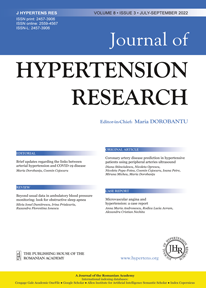2022 April-June Volume 8 Issue 3
EDITORIAL
Brief updates regarding the links between arterial hypertension and COVID-19 disease
Maria Dorobanțu 1, 2 *, Cosmin Cojocaru 1, 2
1 Cardiothoracic Pathology Department, Faculty of Medicine, Carol Davila University of Medicine and Pharmacy, Bucharest, Romania
2 Department of Cardiology, Emergency Clinical Hospital of Bucharest, Bucharest, Romania
Abstract
No abstract available.
J Hypertens Res (2022) 8(3):79–82 [download PDF]
REVIEW
Beyond usual data in ambulatory blood pressure monitoring: look for obstructive sleep apnea
Silviu Ionel Dumitrescu 1, 2, Irina Prisăcariu 1, Ruxandra Florentina Ionescu 1 *
1 Department of Cardiology I, Dr. Carol Davila Central Military Emergency University Hospital, Bucharest, Romania
2 Department of Cardiology, Titu Maiorescu University, Faculty of Medicine, Bucharest, Romania
Abstract
Obstructive sleep apnea (OSA) is a frequent condition in hypertensive patients, characterized by repeated episodes of partial or complete upper airway obstruction during sleep (hypopneas and apneas). The pathophysiological changes in OSA have serious consequences on the individual’s cardiovascular health. The episodes of intermittent hypoxia lead to endothelial dysfunction, arterial stiffness and alterations of nitric oxide metabolism, favoring higher blood pressure (BP) values. Ambulatory blood pressure monitoring (ABPM) can diagnose and evaluate hypertensive patients. There is growing evidence that certain patterns in ABPM results are linked to OSA. OSA is frequently associated with nondipping BP patterns and nocturnal hypertension. Nondipping blood pressure patterns are described as less than a 10% reduction of nocturnal blood pressure values. Patients belonging to this category possess a significant risk for adverse cardiovascular outcomes. Several factors are involved in altering circadian blood pressure variabilities, such as sedentary lifestyle, high sodium diets, smoking, altered neurohormonal regulations, diabetes, and chronic renal disease. Nondipping profiles, especially the reverse pattern, are associated with OSA, irrespective of sleep-related symptoms, making it a potential indicator for screening patients for OSA. Moreover, nondipping BP can be a predictor of BP response to continuous positive airway pressure (CPAP), suggesting the role of ABPM in OSA management.
J Hypertens Res (2022) 8(3):83–86 [download PDF]
ORIGINAL ARTICLE
Coronary artery disease prediction in hypertensive patients using peripheral arteries ultrasound
Diana Stănciulescu 2, Nicoleta Oprescu 2 *, Nicoleta Popa-Fotea 1, 2, Cosmin Cojocaru 1, 2, Ioana Petre 1, 2, Miruna Micheu 2, Maria Dorobanțu 1, 2
1 Department no. 4 of Cardiothoracic Pathology, Carol Davila University of Medicine and Pharmacy, Bucharest, Romania
2 Cardiology Clinic, Emergency Clinical Hospital of Bucharest, Bucharest, Romania
Abstract
Cardiovascular disease is one of the main causes of mortality worldwide, with multifactorial etiology and a high impact on the healthcare system due to the complexity of optimal management. The first two major risk factors are arterial hypertension and atherosclerosis and they both frequently coexist and have a bidirectional causality. A current focus is the prevention and early detection of cardiovascular disease using cost-efficient investigations; however, the prediction of coronary atherosclerosis using non-invasive methods is a goal yet to be achieved. Current vascular ultrasound parameters do not show sufficient sensitivity and specificity for predicting coronary lesions and the intima-media thickness index is now a class III indication in cardiovascular risk assessment. Two new parameters appear to have greater accuracy in predicting CAD: atherosclerosis burden score (ABS) and carotid plaque score (PS). We sought to evaluate the predictive capacity for significant coronary artery disease (>50% luminal stenosis) of the aforementioned parameters. We performed a post-hoc analysis on a cohort of 51 consecutive hypertensive patients admitted for typical chest pain. All patients underwent coronary angiography and were divided into two groups: Group 1 with significant CAD (>50% luminal stenosis on any of the left anterior descending, right coronary artery and/or circumflex artery) and Group 2 with coronary stenosis <50% (non-significant CAD). Atherosclerosis burden score (ABS) and carotid plaque score (PS) were calculated as previously defined based on carotid and femoral ultrasound examination. In our cohort, both ABS and PS independently predicted the existence of coronary lesions after adjusting for age, sex, smoking status, dyslipidemia, diabetes and body mass index (BMI) value. Additionally, ROC-curve analysis demonstrated incremental value for predicting significant coronary artery disease for ABS, which exhibited higher AUC values compared to PS.
J Hypertens Res (2022) 8(3):87–93 [download PDF]
CASE REPORT
Microvascular angina and hypertension: a case report
Anna Maria Andronescu 1, 2 *, Rodica Lucia Avram 1, 2, Alexandru Cristian Nechita 1, 2
1 Department of Medical Semiology , Carol Davila University of Medicine and Pharmacy, Bucharest, Romania
2 Department of Cardiology and Internal Medicine, Sf. Pantelimon Emergency Clinical Hospital, Bucharest, Romania
Abstract
Angina pectoris is one of the most frequent reasons for presentation in the emergency department worldwide and in half of these patients, especially in the young ones, coronary arteries are normal or have non-obstructive stenoses. First described as a clinical entity in 1988, microvascular angina now has precise criteria of diagnosis: symptoms of myocardial ischemia, absence of obstructive coronary artery disease and impaired coronary microvascular function (reduced coronary flow reserve, coronary microvascular spasm, increased microvascular resistance and/or coronary “slow flow” phenomenon). It is frequently associated with cardiovascular risk factors, including arterial hypertension, even in the absence of overt atherosclerotic disease. We present a case of a young female with typical rest angina; electrocardiogram changes are suggestive of myocardial ischemia and normal epicardial coronary arteries in the context of untreated hypertension. She received guideline medical treatment and we presented the patient’s inhospital evolution and at 6-month follow-up visit. Current recommendations for diagnosis, treatment and prognosis of microvascular angina are also discussed.
J Hypertens Res (2022) 8(3):94–98 [download PDF]

